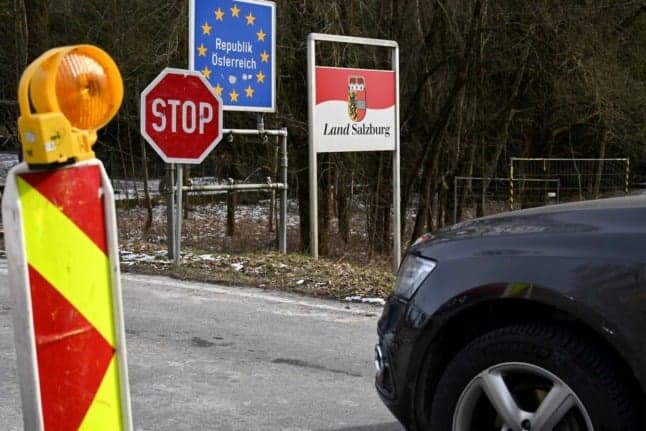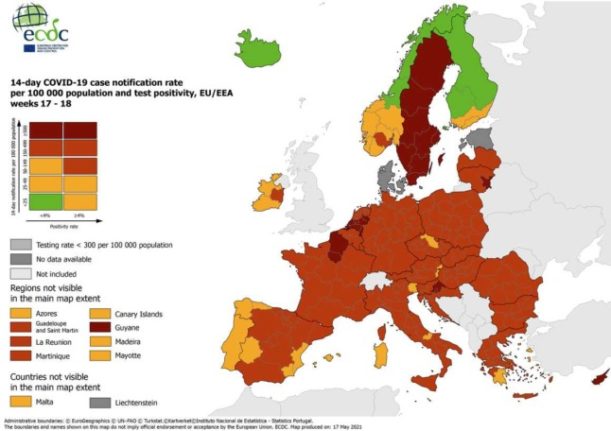EXPLAINED: The new rules for entering Austria

Effective May 19th, Austria relaxed its quarantine for almost all arrivals. Here’s what you need to know.
From Wednesday, May 19th, Austria’s coronavirus quarantine requirement will no longer apply.
Now, entry from most countries will be unrestricted, other than areas deemed ‘high risk’ or where variants of the virus are prevalent.
It is replaced by a new system which requires proof of vaccination, testing or recovery from the virus.
In order to enter, you will have to fill out a form.
The rules will change on June 10th, when pre-travel clearance to enter Austria will only be required if you are coming from a high-risk country or one of the states where variants of the coronavirus are prevalent.
People coming into Austria will still be required to show proof of vaccination, testing or recovery from the virus.
Here’s what you need to know.
What are the new rules for entry?
The new system is based around the EU health agency ECDC’s traffic light system, which differentiates between areas depending on the prevalence of coronavirus infections.
For countries coloured green or orange, entry is unrestricted.
When a country is coloured red, negative coronavirus tests, proof of vaccination or recovery from the virus are required (known as the 3G Rule - see below).
Everyone in quarantine will have the possibility of leaving quarantine after the fifth day with a negative test.
This system therefore resembles that which is in place federally prior to May 19th.
UPDATED: Everything you need to know about Austria’s quarantine rules
The map as at May 17th is shown below. An up to date copy of the map can be found here at this link.

What is the 3G Rule?
Anyone wanting to enter Austria from red or dark red regions will now need to do so pursuant to the so-called ‘3G Rule’.
Unfortunately (or perhaps fortunately) for conspiracy theorists, this has nothing to do with mobile phone networks.
The 3G Rule refers to ‘Getestet, Geimpft, Genesen’ (Tested, Vaccinated, Recovered) and describes the three ways someone can provide evidence they may enter from a ‘red zone’ country.
This means they will need to show evidence of vaccination, a negative test or having recently recovered from the virus.
Are there any exceptions?
Yes. People who want to visit Austria for family and business reasons will be allowed to enter.
Children under the age of 10 are exempt from the test obligation.
Similarly, cross-border commuters are also allowed to enter, as are people in transit.
When the rules were announced on May 18th, Germany - which was coloured red at the time - was also announced as an exception. This means people can arrive from Germany without restriction.
What about the entry form?
Since January, everyone entering Austria has had to fill out a form to do so.
This does not change from May 19th, but will no longer be necessary unless you are coming from a high risk country from June 10th.
More information on the form can be found at the following link.
READ MORE: Here is the form you need to enter Austria
Does this apply to people from all across the world?
Not exactly. While the quarantine has been relaxed, entry bans for non-EU/EFTA citizens remain. Specifically, entry from Brazil, India, South Africa or United Kingdom, which have been identified as "virus variant" countries, is not permitted. A landing ban is also in place for these countries.
READ MORE: Austria to reinstate ban on direct flights from UK
The only exceptions are for humanitarian workers, persons who have been summoned by the courts and people traveling to an international organisation on business, provided they can provide evidence of a negative PCR test result.
In effect, except for these groups, entry into Austria is restricted to Austrian citizens, Austrian residents and citizens of European Union and EFTA countries.
Travel: Who is allowed to enter Austria right now?
Austrian citizens and residents will not be restricted from entry regardless of which countries they have been in for the past ten days, although in most cases they will need to quarantine.
People transiting through Austria without stopping will also not be restricted from entering.
Arrivals from a handful of non-European countries will be allowed to enter: Australia, New Zealand, Singapore and South Korea.
Also, people from Iceland and the Vatican will not be required to quarantine.
More information on this requirement is available at the following link.
UPDATED: Which countries are now on Austria’s quarantine list?
Arrivals from almost every non-European country are restricted.
This means that American citizens are not currently allowed to visit Austria, unless of course they hold Austrian or European citizenship and residency.
LATEST: When will Americans be able to travel to Austria again?
As yet, there is no indication as to when this will change. However, Austria as a EU member will participate in the bloc’s decisions regarding visas and entry.
Official information from the Austrian government is available here.
Comments (3)
See Also
From Wednesday, May 19th, Austria’s coronavirus quarantine requirement will no longer apply.
Now, entry from most countries will be unrestricted, other than areas deemed ‘high risk’ or where variants of the virus are prevalent.
It is replaced by a new system which requires proof of vaccination, testing or recovery from the virus.
In order to enter, you will have to fill out a form.
The rules will change on June 10th, when pre-travel clearance to enter Austria will only be required if you are coming from a high-risk country or one of the states where variants of the coronavirus are prevalent.
People coming into Austria will still be required to show proof of vaccination, testing or recovery from the virus.
Here’s what you need to know.
What are the new rules for entry?
The new system is based around the EU health agency ECDC’s traffic light system, which differentiates between areas depending on the prevalence of coronavirus infections.
For countries coloured green or orange, entry is unrestricted.
When a country is coloured red, negative coronavirus tests, proof of vaccination or recovery from the virus are required (known as the 3G Rule - see below).
Everyone in quarantine will have the possibility of leaving quarantine after the fifth day with a negative test.
This system therefore resembles that which is in place federally prior to May 19th.
UPDATED: Everything you need to know about Austria’s quarantine rules
The map as at May 17th is shown below. An up to date copy of the map can be found here at this link.

What is the 3G Rule?
Anyone wanting to enter Austria from red or dark red regions will now need to do so pursuant to the so-called ‘3G Rule’.
Unfortunately (or perhaps fortunately) for conspiracy theorists, this has nothing to do with mobile phone networks.
The 3G Rule refers to ‘Getestet, Geimpft, Genesen’ (Tested, Vaccinated, Recovered) and describes the three ways someone can provide evidence they may enter from a ‘red zone’ country.
This means they will need to show evidence of vaccination, a negative test or having recently recovered from the virus.
Are there any exceptions?
Yes. People who want to visit Austria for family and business reasons will be allowed to enter.
Children under the age of 10 are exempt from the test obligation.
Similarly, cross-border commuters are also allowed to enter, as are people in transit.
When the rules were announced on May 18th, Germany - which was coloured red at the time - was also announced as an exception. This means people can arrive from Germany without restriction.
What about the entry form?
Since January, everyone entering Austria has had to fill out a form to do so.
This does not change from May 19th, but will no longer be necessary unless you are coming from a high risk country from June 10th.
More information on the form can be found at the following link.
READ MORE: Here is the form you need to enter Austria
Does this apply to people from all across the world?
Not exactly. While the quarantine has been relaxed, entry bans for non-EU/EFTA citizens remain. Specifically, entry from Brazil, India, South Africa or United Kingdom, which have been identified as "virus variant" countries, is not permitted. A landing ban is also in place for these countries.
READ MORE: Austria to reinstate ban on direct flights from UK
The only exceptions are for humanitarian workers, persons who have been summoned by the courts and people traveling to an international organisation on business, provided they can provide evidence of a negative PCR test result.
In effect, except for these groups, entry into Austria is restricted to Austrian citizens, Austrian residents and citizens of European Union and EFTA countries.
Travel: Who is allowed to enter Austria right now?
Austrian citizens and residents will not be restricted from entry regardless of which countries they have been in for the past ten days, although in most cases they will need to quarantine.
People transiting through Austria without stopping will also not be restricted from entering.
Arrivals from a handful of non-European countries will be allowed to enter: Australia, New Zealand, Singapore and South Korea.
Also, people from Iceland and the Vatican will not be required to quarantine.
More information on this requirement is available at the following link.
UPDATED: Which countries are now on Austria’s quarantine list?
Arrivals from almost every non-European country are restricted.
This means that American citizens are not currently allowed to visit Austria, unless of course they hold Austrian or European citizenship and residency.
LATEST: When will Americans be able to travel to Austria again?
As yet, there is no indication as to when this will change. However, Austria as a EU member will participate in the bloc’s decisions regarding visas and entry.
Official information from the Austrian government is available here.
Join the conversation in our comments section below. Share your own views and experience and if you have a question or suggestion for our journalists then email us at [email protected].
Please keep comments civil, constructive and on topic – and make sure to read our terms of use before getting involved.
Please log in here to leave a comment.